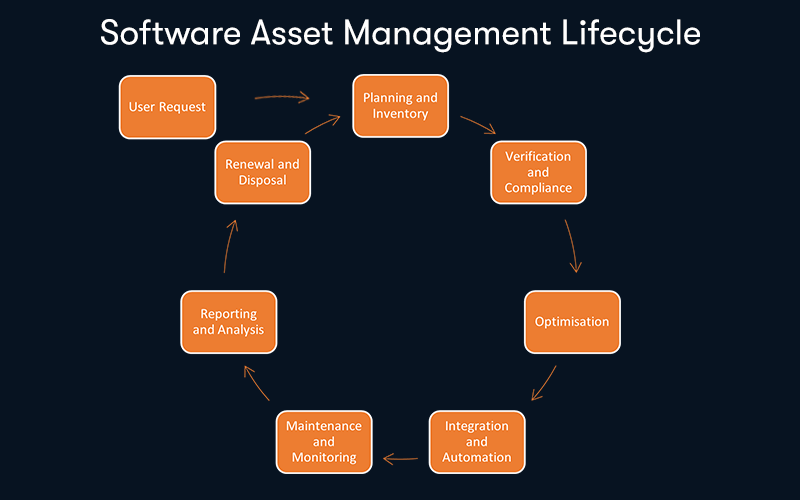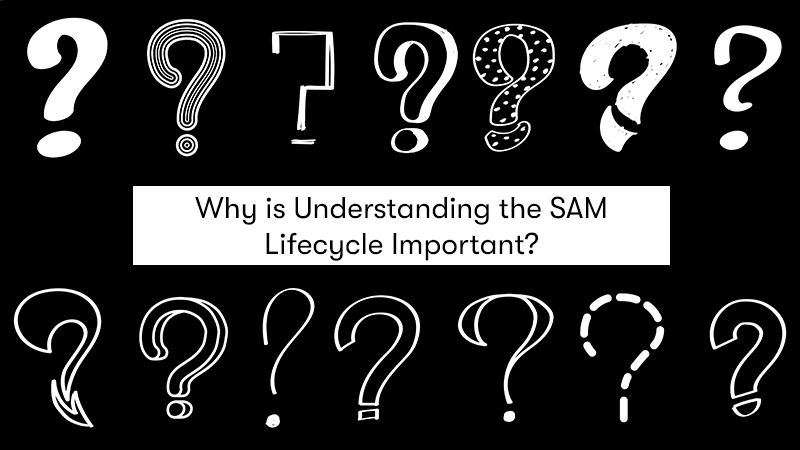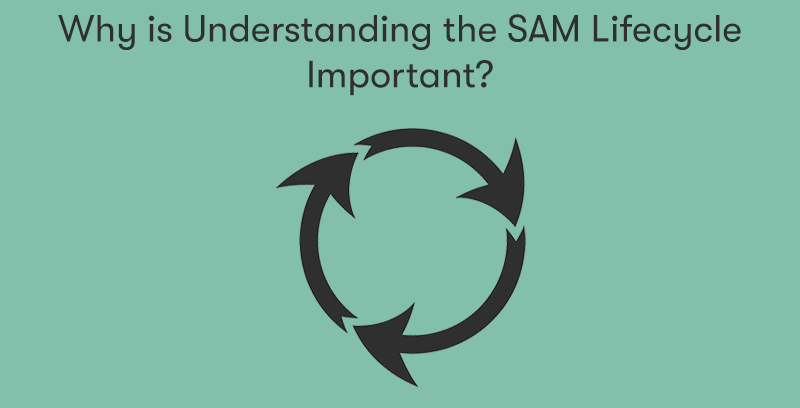Software Asset Management Lifecycle
Welcome to our deep dive into the world of Software Asset Management (SAM) Lifecycle, a cornerstone in modern IT management and a critical process for any organisation navigating the complexities of digital assets. In an era where software drives business operations, understanding the SAM lifecycle is not just advantageous—it's essential.
This lifecycle represents a systematic approach to managing software assets effectively, ensuring organisations maximise value while minimising risks. From the initial stages of planning and inventory to the ongoing compliance, optimisation, and renewal processes, SAM encompasses a range of activities that are integral to operational efficiency and strategic decision-making.
Join us as we explore the intricacies of the SAM lifecycle, uncovering its pivotal role in aligning software investments with business goals and ensuring sustainable growth in an increasingly digital world.
What is the Lifecycle of Software Asset Management (SAM)

The lifecycle of Software Asset Management typically involves several key stages, each with its own set of activities and goals. The lifecycle can be broadly divided into the following phases:
Planning and Inventory
This initial stage involves establishing the scope of the SAM process, defining the objectives, and gathering a comprehensive inventory of all software assets. This includes identifying what software is used, where it is installed, and the relevant licenses.
Verification and Compliance
In this phase, the focus is on verifying that the software in use is compliant with licensing agreements. This involves matching software installations and usage with the license entitlements to ensure no compliance breaches.
Optimisation
Once compliance is assured, the next step is to optimise software assets. This involves ensuring that the organisation makes the most efficient use of its software, reallocating underused licenses, purchasing additional licenses if needed, and retiring redundant or obsolete software.
Integration and Automation
At this stage, efforts are made to integrate SAM practices into the broader IT and business processes. This often involves automating certain aspects of SAM, such as inventory tracking and compliance monitoring, to improve efficiency and accuracy.
Maintenance and Monitoring
Continuous maintenance and monitoring are essential to ensure ongoing compliance and optimisation. This includes regularly reviewing software usage, auditing, and updating the inventory as new software is acquired or retired.
Reporting and Analysis
Regular reporting and analysis are essential to assess the effectiveness of SAM activities. This includes analysing usage patterns, compliance status, cost savings, and other key metrics to inform decision-making and future planning.
Renewal and Disposal
Finally, the lifecycle involves managing the renewal of licenses and properly disposing software assets that are no longer needed. This includes negotiating new licensing agreements and ensuring all legal and regulatory requirements are met when retiring software.
Each phase of the SAM lifecycle requires careful management and coordination to ensure that software assets are used legally, efficiently, and effectively. SAM's goal is to ensure compliance with licensing agreements and optimise software expenditure and usage across the organisation.
What Are the Individual Stages of Software Asset Management?
Software Asset Management involves several individual stages, each focusing on different aspects of managing an organisation's software assets. These stages help ensure compliance, optimise usage, and maximise the value derived from software investments. Here's a breakdown of these stages:
Planning and Policy Development
Establishing a SAM program: Defining the goals, scope, and responsibilities.
Policy development: Creating policies and procedures for acquiring, using, and managing software.
Inventory Management
Inventory tracking: Cataloguing all software assets within the organisation.
Discovery tools deployment: Using automated tools to identify installed software across the network.
License Management
License procurement and documentation: Managing the acquisition of software licenses and maintaining records.
License compliance: Ensuring that the organisation adheres to the terms and conditions of software licenses.
Demand Management
Assessing software needs: Determining the actual software requirements of the organisation.
Request and approval process: Implementing a system for software requests and approvals to control proliferation and ensure necessary acquisitions.
Usage and Optimisation
Monitoring software usage: Tracking how software is being used to identify underutilised assets.
Software re-harvesting and optimisation: Reallocating underused licenses and optimising the software portfolio.
Financial Management
Budgeting and cost control: Planning and monitoring the costs associated with software acquisition and maintenance.
Chargeback and Show back: Allocating software costs back to business units or showing them the value they receive from software investments.
Risk Management and Compliance
Risk assessment: Identifying and managing risks associated with software assets.
Audit preparation and response: Preparing for and responding to internal or external software audits.
Contract Management
Managing software contracts: Overseeing contracts throughout their lifecycle, from negotiation to renewal or termination.
Vendor management: Maintaining relationships with software vendors and suppliers.
Performance and Value Assessment
Reporting and analytics: Generating reports on various software usage, compliance, and expenditure aspects.
Continuous improvement: Regularly assess the SAM program's performance and identify areas for improvement.
Disposal and Retirement
Managing the end-of-life process for software assets, including decommissioning and ensuring compliance with disposal policies and regulations.
Each stage in the SAM lifecycle is interrelated and builds upon the previous stages. Effective management at each stage is crucial for maximising the value and minimising the risks associated with software assets. Organisations often rely on specialised software tools and cross-functional collaboration to manage these stages effectively.
Why is Understanding the SAM Lifecycle Important?

Understanding the Software Asset Management lifecycle is essential for several reasons, as it plays a crucial role in managing an organisation's software assets effectively. Here are key reasons why understanding the SAM lifecycle is vital:
Cost Savings and Financial Efficiency
Avoids Overspending: Organisations can avoid unnecessary software purchases and renewals by understanding the SAM lifecycle.
Optimises Investments: Organisations can ensure they get the most value from their software investments.
Compliance and Legal Risks
Ensures Compliance: Proper SAM helps maintain compliance with software licenses, reducing legal risks associated with noncompliance.
Prepares for Audits: Understanding SAM prepares organisations for software audits, minimising the risks of penalties and fines.
Operational Efficiency
Improves IT Operations: Efficient software management streamlines IT operations, ensuring the right tools are available and operational.
Reduces Downtime: Organisations can minimise system downtime related to software issues by managing software effectively.
Risk Management
Identifies and Mitigates Risks: Understanding SAM helps identify risks associated with software (like end-of-life issues) and mitigate them effectively.
Enhances Security: Proper software management can improve cybersecurity by ensuring software is up-to-date and compliant with security standards.
Strategic Planning and Decision Making
Informs IT Strategy: SAM provides critical data that can inform broader IT and business strategies.
Supports Future Investments: Insights from SAM can guide future software purchases and investments.
Resource Optimisation
Maximises Usage: SAM helps ensure software licenses are fully utilised, avoiding waste.
Reallocates Resources: It allows for reallocating underutilised software, ensuring resources are used efficiently.
Improved Vendor Management
Enhances Vendor Relationships: Understanding SAM aids in managing relationships with software vendors, leading to better support and potentially more favourable terms.
Negotiates Better Contracts: Knowledge of software usage and needs can lead to more effective negotiations with vendors.
Organisational Agility
Supports Scalability: A well-understood SAM process can easily scale with the organisation, accommodating growth or changes in software needs.
Facilitates Change Management: Effective SAM aids in managing the software aspects of organisational change.
Understanding the SAM lifecycle is critical for optimising software investments, reducing risks, ensuring legal and regulatory compliance, improving operational efficiency, and supporting strategic business objectives. It is a key component of IT governance and overall business management.
Final Notes on the Lifecycle of SAM (Software Asset Management)
In conclusion, understanding the Software Asset Management lifecycle is essential for any organisation looking to maximise the value of its software assets. SAM ensures compliance, financial efficiency, and operational effectiveness through phases such as planning, inventory management, license management, and optimisation.
It is a critical process that not only helps in cost savings but also mitigates legal risks, enhances security, and supports strategic planning. Organisations can improve IT operations, optimise resources, and strengthen vendor relationships by effectively managing software assets.
Embracing the principles of SAM is not just about adhering to best practices; it's a strategic approach that enhances organisational agility and prepares businesses for the challenges of an ever-evolving technological landscape.


